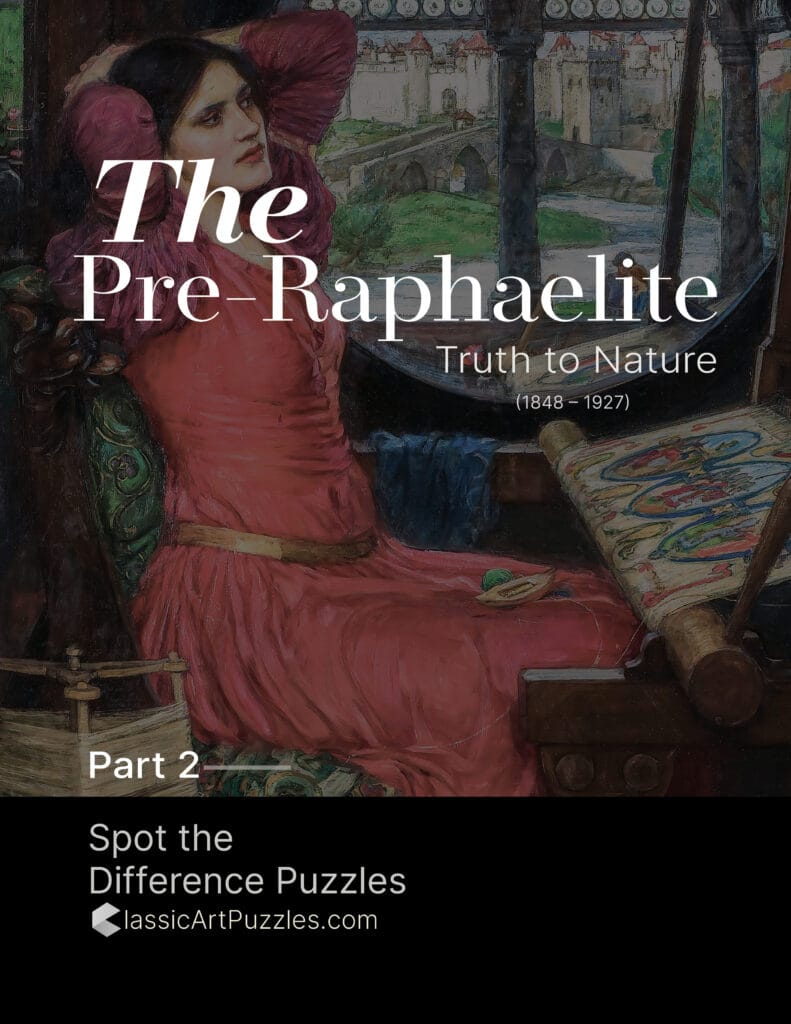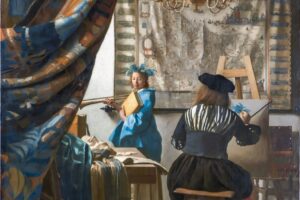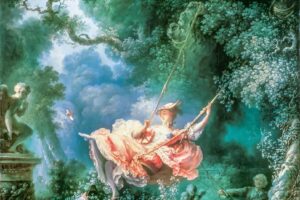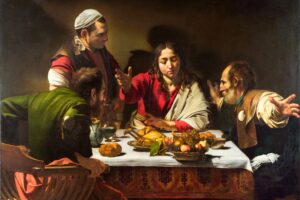Table of Contents
Overview
Painted in 1883 by John William Waterhouse (1849–1917), The Favourites of the Emperor Honorius is a historical scene that illustrates the distractions of power and the fragility of empires. The young Roman emperor Honorius sits slumped on his throne, feeding pigeons with absorbed indifference, while his ministers and advisors bow before him. Their reverence is directed toward authority, yet the ruler himself is inattentive, consumed by trivial pursuits.
Waterhouse captures this moment as an allegory of decline: an empire in peril, its leader more concerned with pets than with politics. The meticulous detail — mosaics, drapery, incense, and pigeons scattering across the marble floor — reflects Pre-Raphaelite precision while also expressing late-Victorian anxieties about governance, distraction, and responsibility.
When first exhibited, the painting was praised for its richness of color and narrative irony. Today, it stands as a brilliant fusion of historical painting with symbolic commentary.
Artist
John William Waterhouse (1849–1917) was a British painter known for blending Pre-Raphaelite ideals with classical and mythological subjects. Although working decades after the Brotherhood’s founding, his luminous palettes, romantic narratives, and symbolic intensity aligned him with their tradition. Waterhouse often explored themes of fate, temptation, and moral choice, depicting figures from Homer, Shakespeare, and history. His works remain some of the most beloved of the Victorian era.
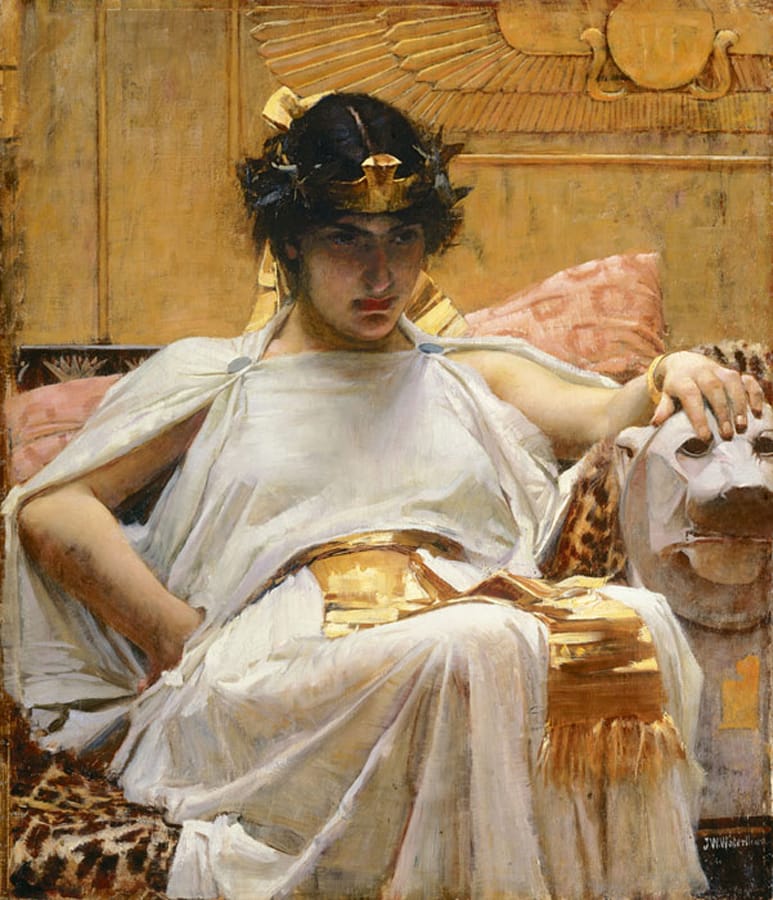
The Story Behind the Painting
The Emperor Honorius
Honorius (AD 384–423) was a Western Roman Emperor remembered less for military victories than for presiding over the empire’s decline. Contemporary accounts describe him as weak and disengaged from the urgent crises of his time.
A Symbol of Neglect
Waterhouse interprets Honorius as a young man distracted by pigeons, oblivious to the advisors bowing at his side. The contrast between ceremony and neglect creates a powerful moral allegory about leadership and misplaced attention.
Victorian Resonance
For Victorian audiences, the message extended beyond antiquity: it was a cautionary tale about governance, responsibility, and the dangers of distraction — themes that resonated strongly in an age of empire.
Composition and Subjects
Honorius on the Throne
Seated in a red robe, Honorius leans languidly, feeding pigeons from a golden dish. His downcast gaze shows disinterest in affairs of state.
The Courtiers
A group of ministers bows deeply, robes sweeping across the patterned marble. Their gestures of reverence seem hollow in the face of the emperor’s inattentiveness.
The Birds
The pigeons — clustered on the floor, perched on his lap, and fluttering at his side — become the true “favourites” of the title, symbolic of misplaced devotion and neglect of duty.
Art Style and Techniques
Pre-Raphaelite Precision
Every detail — from the tiled floor to embroidered garments — is rendered with exacting clarity, typical of Waterhouse’s Pre-Raphaelite inheritance.
Symbolism
- Pigeons: Distraction, triviality, misplaced care.
- Incense burner: Suggests ritual and reverence, now overshadowed by empty gestures.
- Architectural detail: A reminder of Rome’s grandeur, ironically decaying under weak rule.
Dramatic Irony
The advisors’ exaggerated gestures of respect contrast sharply with the emperor’s disregard, making the painting almost theatrical in its irony.
Featured in Our Collection
The Favourites of the Emperor Honorius is part of our Pre-Raphaelite Spot-the-Difference Puzzle Flipbook P2. With its scattered pigeons, flowing robes, and intricate details of Roman architecture, it offers an absorbing challenge for puzzle lovers while introducing a narrative of history, symbolism, and decline.
The Emperor and His Birds
A young emperor in crimson, birds fluttering at his feet, while bowed courtiers offer hollow gestures of loyalty. In Waterhouse’s The Favourites of the Emperor Honorius, the decline of Rome becomes a parable of power misplaced.
More About Artist

John William Waterhouse RA (baptized April 6, 1849 – February 10, 1917) was a renowned English painter closely associated with the Pre-Raphaelite style and Victorian Romanticism. Born in Rome to English painter parents, Waterhouse moved to London in childhood, where he was exposed to a rich artistic environment near the Victoria and Albert Museum. He trained at the Royal Academy of Art, initially studying sculpture before switching to painting. Waterhouse became famous for his vibrant, detailed depictions of mythological, literary, and classical subjects, bringing the Pre-Raphaelite aesthetic into the early 20th century.
Artist Style and Movement
Waterhouse’s style bridges Academic art and Pre-Raphaelite influences, characterized by luminous colors, precise detail, and narrative richness. His subjects often derived from classical literature, myths, and poetry—especially works by Tennyson, Shakespeare, and Homer—delivered with romanticism and emotional intensity. He focused on female protagonists, enchantresses, and tragic heroines, exploring themes of love, fate, and destiny. Though rooted in Victorian ideals, his brushwork sometimes reflected Impressionist influences.
Artwork Profile
- After the Dance (1876): An early success capturing a courtly scene post-dance with refined detail and vibrant colors.
- A Sick Child Brought Into the Temple of Aesculapius (1877): A dramatic and poignant painting reflecting ancient themes of healing and faith.
- Diogenes (1882): A philosophical portrait of the Cynic philosopher Diogenes, embodying simplicity and defiance.
- The Favourites of the Emperor Honorius (1883): A richly detailed historical scene depicting imperial court life.
- Consulting the Oracle (1884): An evocative scene emphasizing Greek antiquity and mysticism.
- The North-West Passage (1874): A patriotic narrative painting recalling British exploration.
- Penelope and the Suitors (1912): Reflects Waterhouse’s fascination with Homeric epics, childbirth, and female virtues.
- “Am Half-Sick of Shadows,” Said the Lady of Shalott (1915): A late portrayal of Tennyson’s tragic heroine, encapsulating Waterhouse’s romantic and symbolic style.
John William Waterhouse’s enduring legacy lies in his masterful synthesis of Pre-Raphaelite romanticism and Victorian poetic storytelling. His paintings display an exquisite balance of detailed craftsmanship and emotional narrative, making him one of the last significant bearers of the Pre-Raphaelite tradition into the 20th century. His works continue to captivate with their rich color palettes, mythic themes, and profound human emotions.

